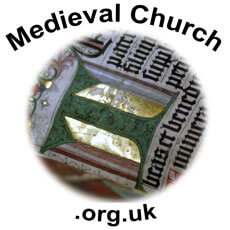Augustinians
Theology on the Web helps over 2.5 million people every year to find high quality theological resources that will help to equip them to serve God and to know Him better (2 Timothy 2:15). Like other websites that provide free services, it is dependent on donations to enable it to grow and develop and only 0.004% of visitors currently do so. If you would like to support this site, please use one of the options to the right of this message.
Synopsis
After receiving baptism, Augustine and some friends of his retired to the neighborhood of Tagaste for the purpose of leading a purely spiritual life. Evodius, Alypius, and Severus came with him from Italy: they were joined by Profuturus, Forturiatus, Possidius, Urbanus, Bonifacius, and Peregrinus. The community was formed in 388; and the rich donations of Bishop Valerius of Hippo, and, still more, the accession of Augiistine to the episcopal chair, soon made it very flourishing. In the beginning, the Gospels served as the only rule. The one hundred and ninth and two hundred and eleventh Epistles of Angustine (Bened. edit.), dating from the year 423, give only the rules for the nuns of Hippo. When and where the so-called rules of Augustine originated is uncertain; but they belong, at any rate, not to him. Similar communities were often formed in Italy, such as the John-Bonites, the Hermits of Tuscany, the Brittinians, etc., of which especially the last-mentioned distinguished themselves by a high degree of austerity. These communities were united by Innocent IV., who, by a bull of Jan. 17, 1244, gave them the rules of St. Augustine. Alexander IV. was very anxious to further consolidate the union. Lanfranc Septala of Milan was made general of the order; and four provincials, respectively for Italy, Spain, France, and Germany, were appointed. By a bull of April 13, 1256, the whole organization was sanctioned. After this time the order spread rapidly. In the beginning of the fifteenth century it numbered forty-two provinces, besides the vicarates of India and Moravia. two thousand monasteries, and thirty thousand monks. In 1567 Pius V. gave it the same rank and privileges as the mendicant orders.
The Augustinian nuns formed their first community at Hippo, under Perpetua, the sister of Augustine. An outline of their rule is given in the two hundred and eleventh letter of Augustine. An Augustinian nunnery was founded at Venice in 1177 l)y Alexander III., which the Princess Julia, a daughter of the Emperor Frederick I., entered as its first abbess. The celebrated Nunnery of Tournoy was founded iii 1124 by Pierre de Champion.
By degrees, as the order spread and grew rich, laxity and corruption crept in; and. as a reaction, independent congregations were formed at Illiceto and Carbonaria towards the close of the fourteenth century, at Perouse and in the Lombardy in the beginning of the fifteenth century, in Saxony in 1492, etc. At attempt at a radical reform was made in Portugal by Thomas à Jesu, who died in 1582. The result was the formation of the congregation of the Barefooted Augustinians. Their rules were first introduced in the Monastery of Talavera. Their organization was finally completed, and confirmed by Gregory XV. in 1622. They spread much in Japan, the Philippines, Peru, etc. In Spain every province had a hermitage, to which those who wished to live as anchorets could retire, and find perfect solitude and seclusion. Johann Staupitz, well known in connection with Luther, became vicar-general of the order in Germany in 1515; but it was just Luther’s appearance; which in Germany brought the order in speedy decadence. In the nineteenth century a great number of the monasteries of the order have been secularized; in 1850, however, there were still about one hundred left in Italy and in France.
W. Chlebus (Zöckler) , "Augustinian Monks and Nuns," Philip Schaff, ed., A Religious Encyclopaedia or Dictionary of Biblical, Historical, Doctrinal, and Practical Theology, 3rd edn, Vol. 1. Toronto, New York & London: Funk & Wagnalls Company, 1894. p.173.
Primary Sources
 Raymond Canning, translator. The Rule of St. Augustine. Image Books, 1986. Pbk. ISBN: 0385232411.
pp.128. Raymond Canning, translator. The Rule of St. Augustine. Image Books, 1986. Pbk. ISBN: 0385232411.
pp.128. |
Secondary Sources
| Ralph Hanna, "Augustinian Canons and Middle English Literature," in A.S.G. Edwards, Vincent Gillespie & Ralph Hanna, eds., The English Medieval Book: Studies in Memory of Jeremy Griffiths. London: British Library, 2000. pp. 27-42. | |
| Francis X. Roth, The English Austin Friars: 1249-1538. Cassiciacum: Studies in St. Augustine and the Augustian Order, 6-7. 2 Vols. New York: Augustinian Historical Institute, 1961-1966. pp. viii + 673. |
Related Subjects
Premonstrants
 |
|
 |
|
 |








